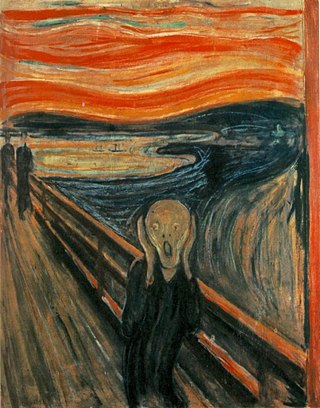
Panphobia, omniphobia, pantophobia, or panophobia is a vague and persistent dread of some unknown evil. [1] Panphobia is not registered as a type of phobia in medical references.

Panphobia, omniphobia, pantophobia, or panophobia is a vague and persistent dread of some unknown evil. [1] Panphobia is not registered as a type of phobia in medical references.
The term panphobia was first coined by Théodule-Armand Ribot in his 1911 work The Psychology of the Emotions. [2] He defined it as "a state in which a patient fears everything or nothing, where anxiety, instead of being riveted on one object, floats as in a dream, and only becomes fixed for an instant at a time, passing from one object to another, as circumstances may determine." The term comes from the Greek πᾶν - pan, neuter of "πᾶς" - pas, "all" [3] and φόβος - phobos, "fear". [4] The Greek root word pan (ex. pan-ic) describes "the unpleasant state inflicted by the intervention of the god Pan." [2] Pan is characterized as a human–animal hybrid who "appeared as the agent of panic fear (that collective, animal-like disorder that seizes military camps at rest, especially at night) and of a form of individual possession (panolepsy)." [5] According to Herodotus, it was Pan who was able to lead the Athenians to victory in the Battle of Marathon, forcing the Persians to flee. [2] It has been argued that pantophobia may actually be considered the more accurate name to describe the non-specificity associated with a fear of all. [2]
There is no specific phobia in the DSM-5 which provides criteria for an all-encompassing fear of everything, though the defining symptom for generalized anxiety disorder in this manual is "excessive anxiety and worry (apprehensive expectation) about a number of events or activities." Another very relatable state of mind is paranoia, in which one fears that unknown threats could, and most likely will, come from anyone, with distrust potentially leading to a loss of touch with reality. Delusional disorder is a more severe form of this type of disorder. Relevant academic literature may point to panphobia as merely a piece of such more complex states of mental disorder. Pseudoneurotic schizophrenia may be diagnosable in patients who, in addition to panphobia, also exhibit symptoms of pananxiety, panambivalence, and to a lesser extent, chaotic sexuality. [6] These persons differ from generalized anxiety sufferers in that they have "free-floating anxiety that rarely subsides" and are clinically diagnosable as having borderline personality disorder in the DSM-IV-TR. No significant changes related to this personality disorder were made in transitioning to the DSM-5, suggesting the diagnostic criteria are still appropriate. [7]
Paranoia is an instinct or thought process that is believed to be heavily influenced by anxiety or fear, often to the point of delusion and irrationality. Paranoid thinking typically includes persecutory beliefs, or beliefs of conspiracy concerning a perceived threat towards oneself. Paranoia is distinct from phobias, which also involve irrational fear, but usually no blame.

A mood disorder, also known as an affective disorder, is any of a group of conditions of mental and behavioral disorder where a disturbance in the person's mood is the main underlying feature. The classification is in the Diagnostic and Statistical Manual of Mental Disorders (DSM) and International Classification of Diseases (ICD).

Anxiety disorders are a cluster of mental disorders characterized by significant and uncontrollable feelings of anxiety and fear such that a person's social, occupational, and personal function are significantly impaired. Anxiety may cause physical and cognitive symptoms, such as restlessness, irritability, easy fatiguability, difficulty concentrating, increased heart rate, chest pain, abdominal pain, and a variety of other symptoms that may vary based on the individual.
Specific phobia is an anxiety disorder, characterized by an extreme, unreasonable, and irrational fear associated with a specific object, situation, or concept which poses little or no actual danger. Specific phobia can lead to avoidance of the object or situation, persistence of the fear, and significant distress or problems functioning associated with the fear. A phobia can be the fear of anything.
In psychology, alogia is poor thinking inferred from speech and language usage. There may be a general lack of additional, unprompted content seen in normal speech, so replies to questions may be brief and concrete, with less spontaneous speech. This is termed poverty of speech or laconic speech. The amount of speech may be normal but conveys little information because it is vague, empty, stereotyped, overconcrete, overabstract, or repetitive. This is termed poverty of content or poverty of content of speech. Under Scale for the Assessment of Negative Symptoms used in clinical research, thought blocking is considered a part of alogia, and so is increased latency in response.
Avoidant personality disorder (AvPD) is a Cluster C personality disorder characterized by excessive social anxiety and inhibition, fear of intimacy, severe feelings of inadequacy and inferiority, and an overreliance on avoidance of feared stimuli as a maladaptive coping method. Those affected typically display a pattern of extreme sensitivity to negative evaluation and rejection, a belief that one is socially inept or personally unappealing to others, and avoidance of social interaction despite a strong desire for it. It appears to affect an approximately equal number of men and women.

Aquaphobia is an irrational fear of water.
Osmophobia or olfactophobia refers to a fear, aversion, or psychological hypersensitivity to odors. The phobia generally occurs in chronic migraine sufferers who may have odor triggered migraines. Such migraines are most frequently triggered by foul odors, but the hypersensitivity may extend to all odors. One study found as many as 25% of migraine sufferers had some degree of osmophobia. The condition may also be present in individuals in substance withdrawal, specifically opioid withdrawal syndrome, where it is usually associated with nausea and/or vomiting.
Phonophobia, also called ligyrophobia or sonophobia, is a fear of or aversion to loud sounds —a type of specific phobia. It is a very rare phobia which is often the symptom of hyperacusis. Sonophobia can refer to the hypersensitivity of a patient to sound and can be part of the diagnosis of a migraine. Occasionally it is called acousticophobia.

Fear of the dark is a common fear or phobia among children and, to a varying degree, adults. A fear of the dark does not always concern darkness itself; it can also be a fear of possible or imagined dangers concealed by darkness. Some degree of fear of the dark is natural, especially as a phase of child development. Most observers report that fear of the dark seldom appears before the age of two years. When fear of the dark reaches a degree that is severe enough to be considered pathological, it is sometimes called scotophobia, or lygophobia.
Mysophobia, also known as verminophobia, germophobia, germaphobia, bacillophobia and bacteriophobia, is a pathological fear of contamination and germs. The term was coined by William A. Hammond in 1879 when describing a case of obsessive–compulsive disorder (OCD) exhibited in repeatedly washing one's hands. Mysophobia has long been related to compulsive hand washing. Names pertaining directly to the abnormal fear of dirt and filth include molysmophobia or molysomophobia, rhypophobia, and rupophobia, whereas the terms bacillophobia and bacteriophobia specifically refer to the fear of bacteria and microbes in general.
A spectrum disorder is a mental disorder that includes a range of linked conditions, sometimes also extending to include singular symptoms and traits. The different elements of a spectrum either have a similar appearance or are thought to be caused by the same underlying mechanism. In either case, a spectrum approach is taken because there appears to be "not a unitary disorder but rather a syndrome composed of subgroups". The spectrum may represent a range of severity, comprising relatively "severe" mental disorders through to relatively "mild and nonclinical deficits".
Phobophobia is a phobia defined as the fear of phobias, or the fear of fear, including intense anxiety and unrealistic and persistent fear of the somatic sensations and the feared phobia ensuing. Phobophobia can also be defined as the fear of phobias or fear of developing a phobia. Phobophobia is related to anxiety disorders and panic attacks directly linked to other types of phobias, such as agoraphobia. When a patient has developed phobophobia, their condition must be diagnosed and treated as part of anxiety disorders.
Gymnophobia is a fear (phobia) of nudity.

Gephyrophobia is the anxiety disorder or specific phobia characterized by the fear of bridges and tunnels. As a result, sufferers of gephyrophobia may avoid routes that will take them over bridges, or if they are a passenger, will act very apprehensively when passing over a bridge. The term gephyrophobia comes from the Greek γέφυρα (gephura), meaning "bridge", and φόβος (phobos), meaning "fear".

Fear of fish or ichthyophobia ranges from cultural phenomena such as fear of eating fish, fear of touching raw fish, or fear of dead fish, up to irrational fear. Selachophobia, or galeophobia, is the specific fear of sharks.
According to the DSM-IV classification of mental disorders, the injury phobia is a specific phobia of blood/injection/injury type. It is an abnormal, pathological fear of having an injury.
Scopophobia, scoptophobia, or ophthalmophobia is an anxiety disorder characterized by a morbid fear of being seen in public or stared at by others.
Nosocomephobia is defined as the excessive fear of hospitals.
Cyclothymia, also known as cyclothymic disorder, psychothemia / psychothymia, bipolar III, affective personality disorder and cyclothymic personality disorder, is a mental and behavioural disorder that involves numerous periods of symptoms of depression and periods of symptoms of elevated mood. These symptoms, however, are not sufficient to indicate a major depressive episode or a manic episode. Symptoms must last for more than one year in children and two years in adults.